Primo Felotti – The Tale of a Lattoniere Extraordinaire
Author: Ellaspede Date Posted:24 April 2025

I recently stumbled across an internet photo of an MV Agusta tank and in the foreground was a book written by Primo Felotti.
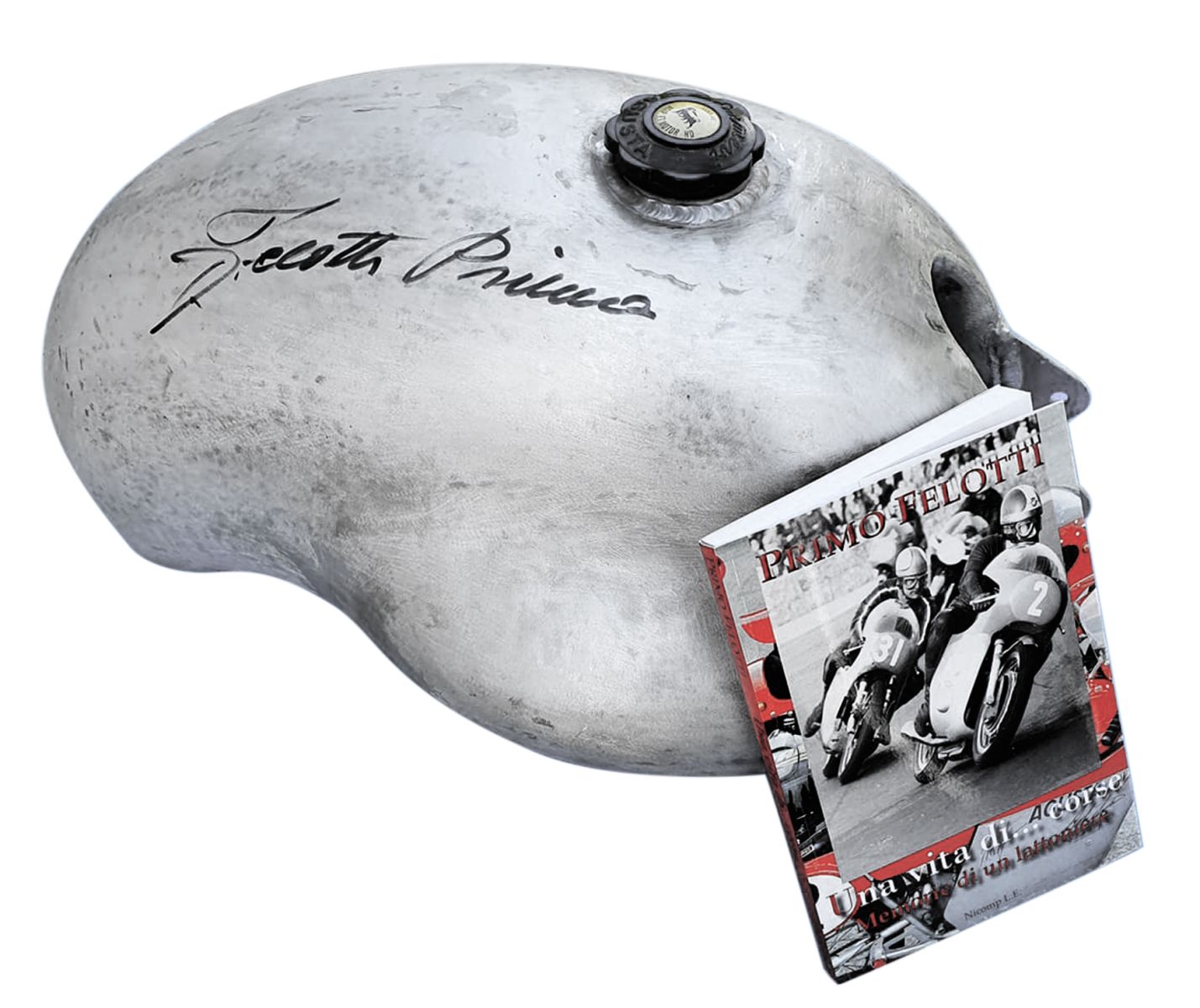
Paul Galles had posted the photo along with the information that the author was actually the designer and fabricator of the now famous tank design. Paul was at a dinner with Primo in 2003 when he told him the story of how, in circa 1953, he formed a curvaceous tank in aluminium to present to the MV Agusta board for consideration. It made it to production in 1954 for the 175 Sport and Super Sport models the tank was soon christened the ‘Disco Volante’, as it looked like a UFO.
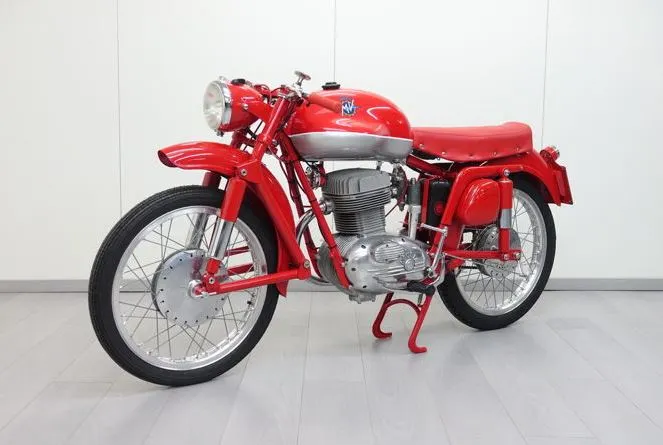
This tank is considered one of the most beautiful ever made.
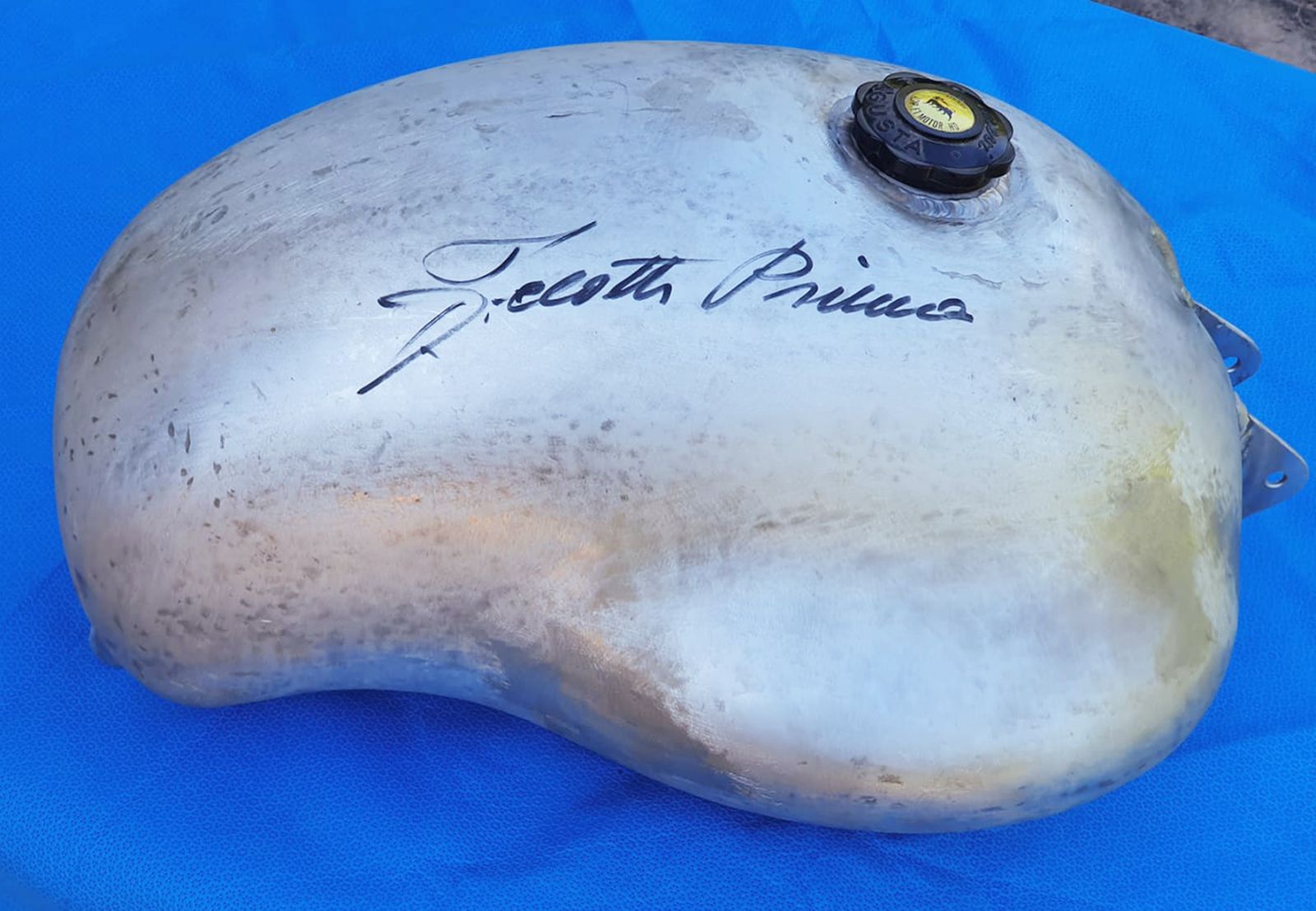
At the dinner, Primo went on to draw the individual shapes he cut, formed and welded on a napkin which Paul has kept. To top off his experience, Paul also acquired the last disco tank that Primo formed in circa 2009 when he was 85 years of age.
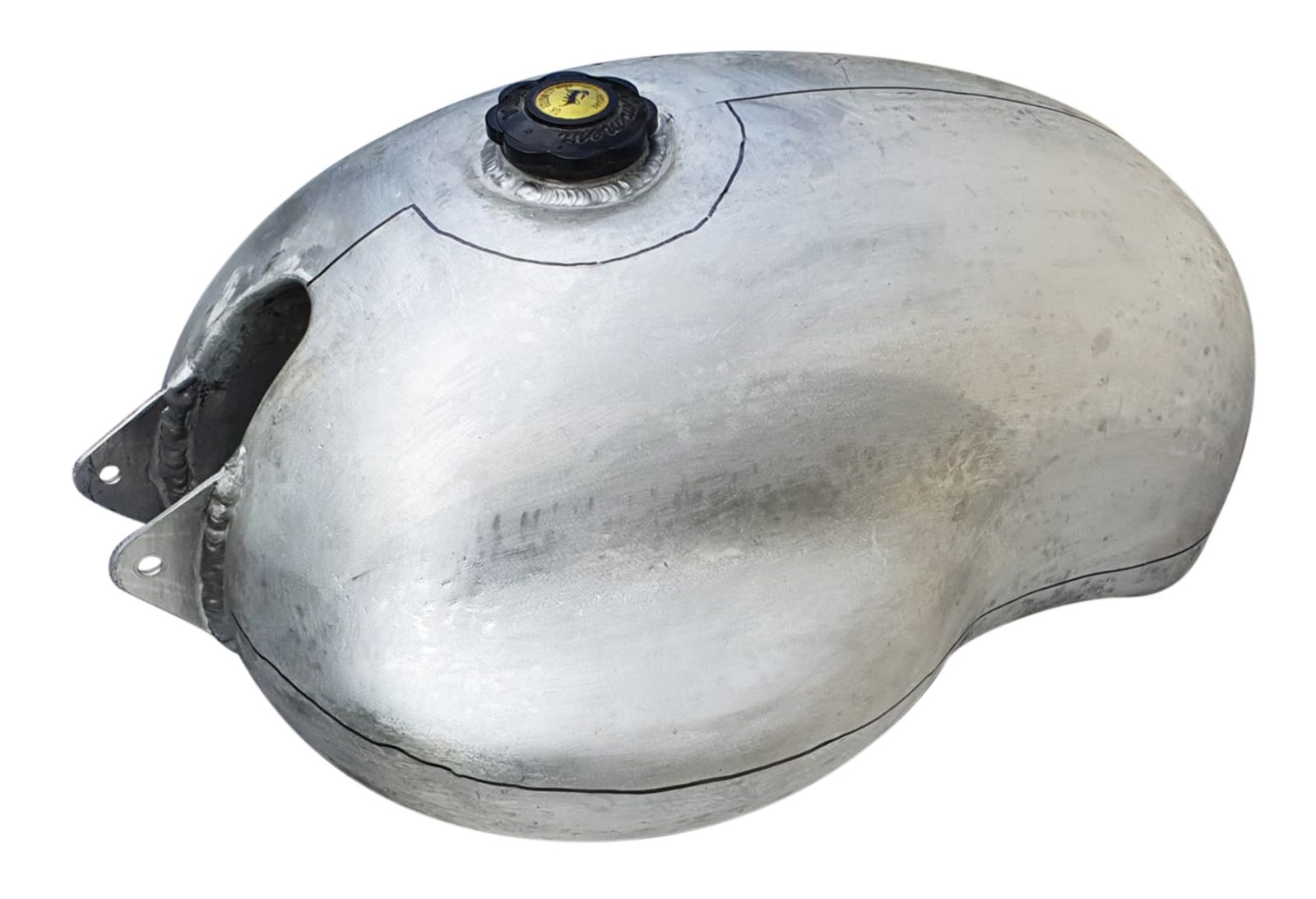
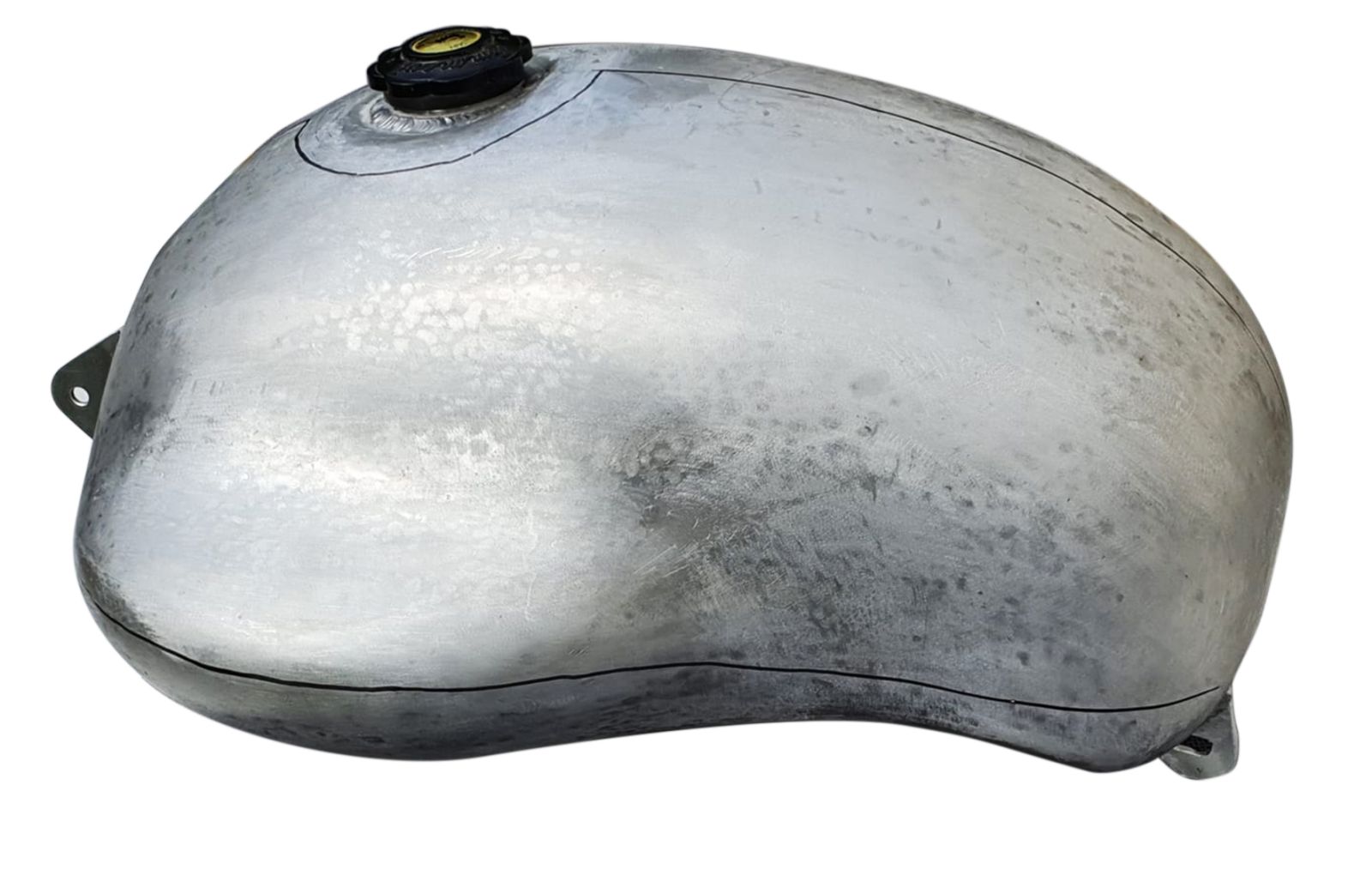
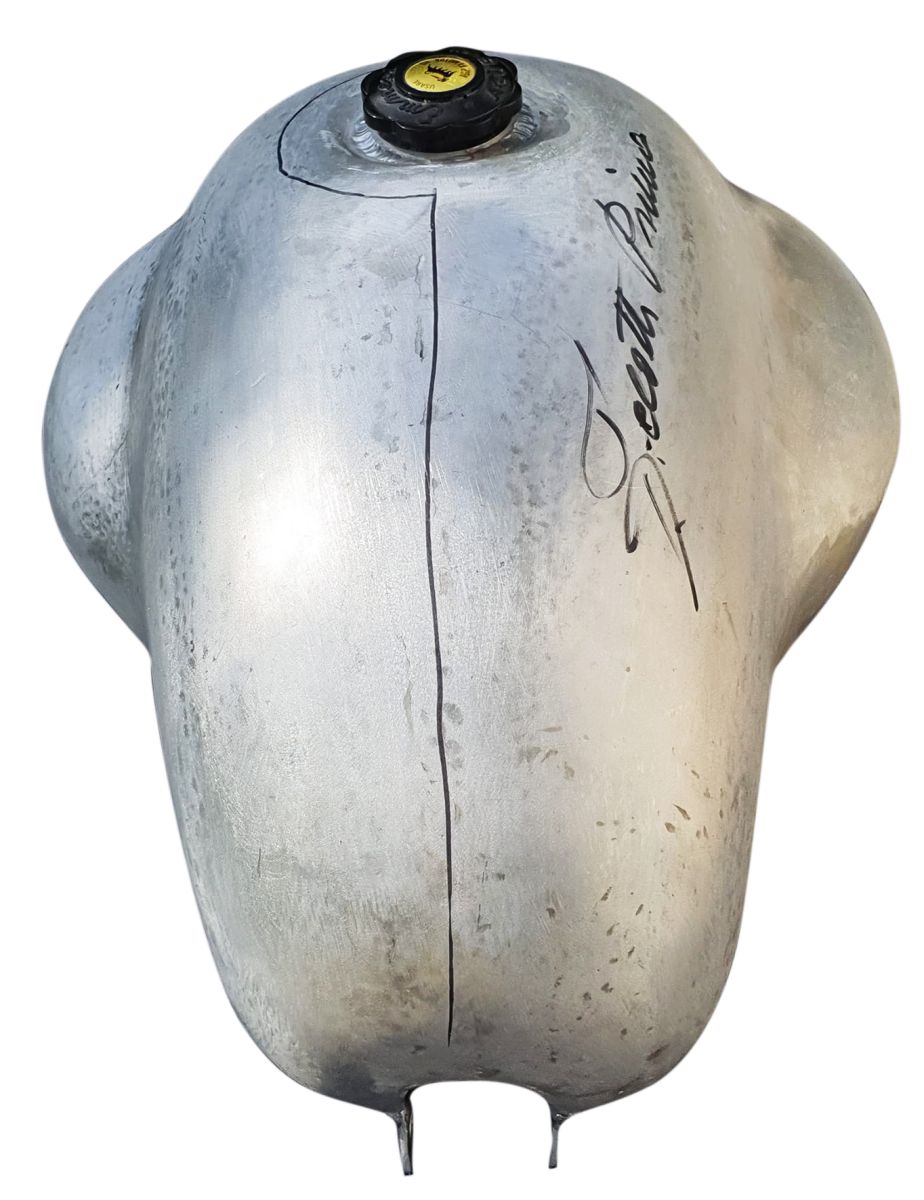
It too was in aluminium like the first prototype and left unpainted, to show the smoothed hammer marks of the master which he also signed. Paul also included a photo where he marked the weld lines on the tank to identify the separate pieces.
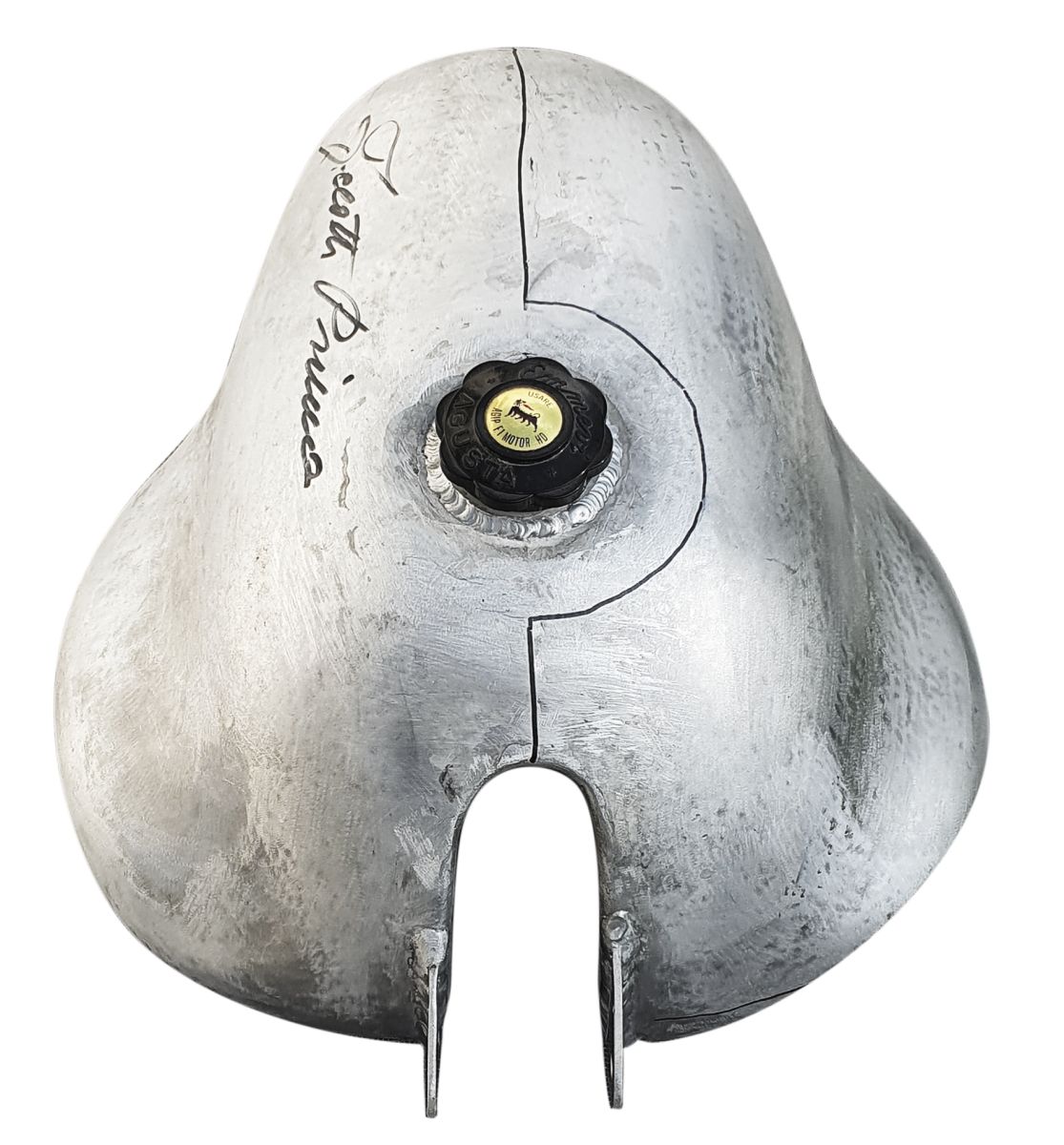
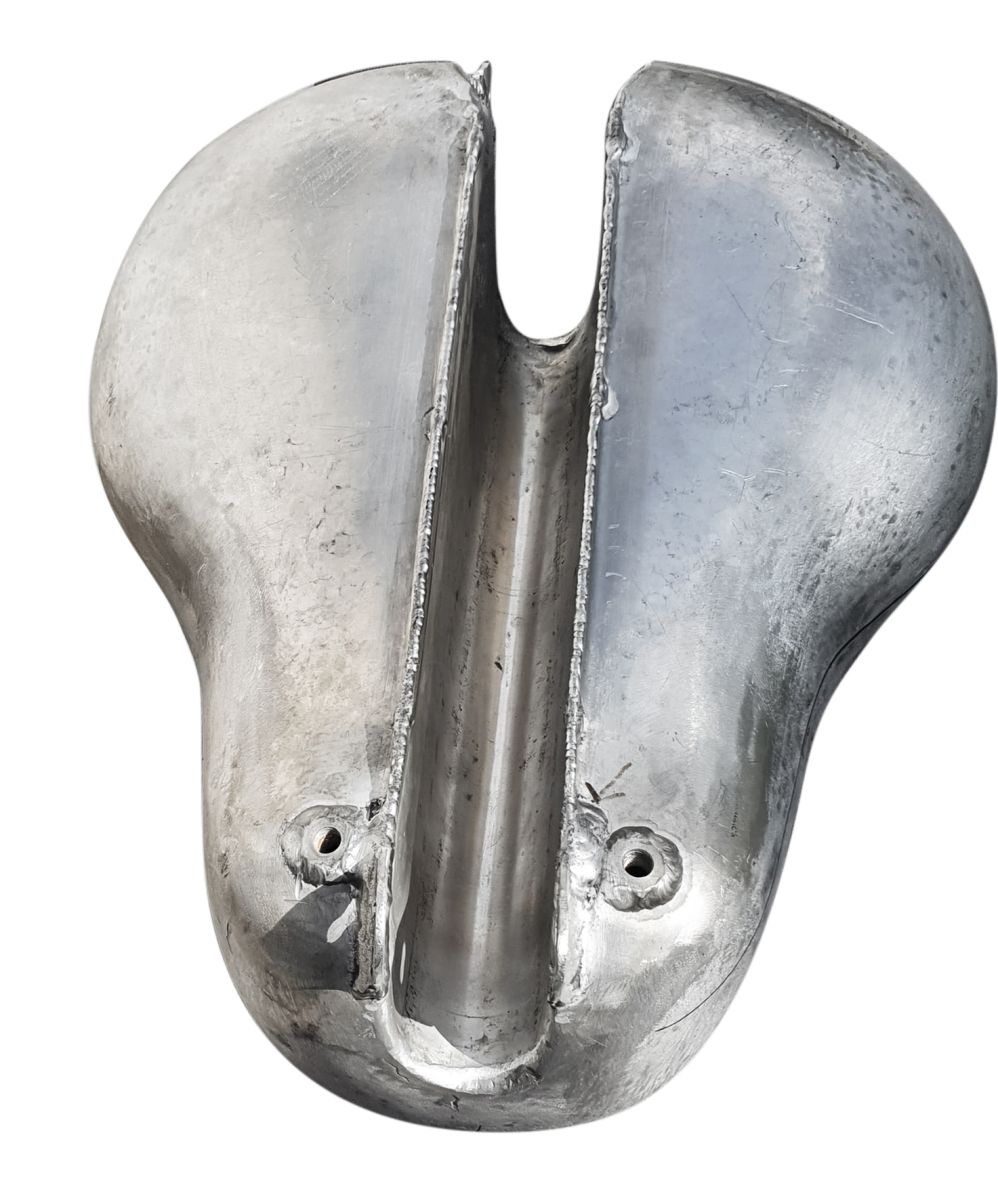
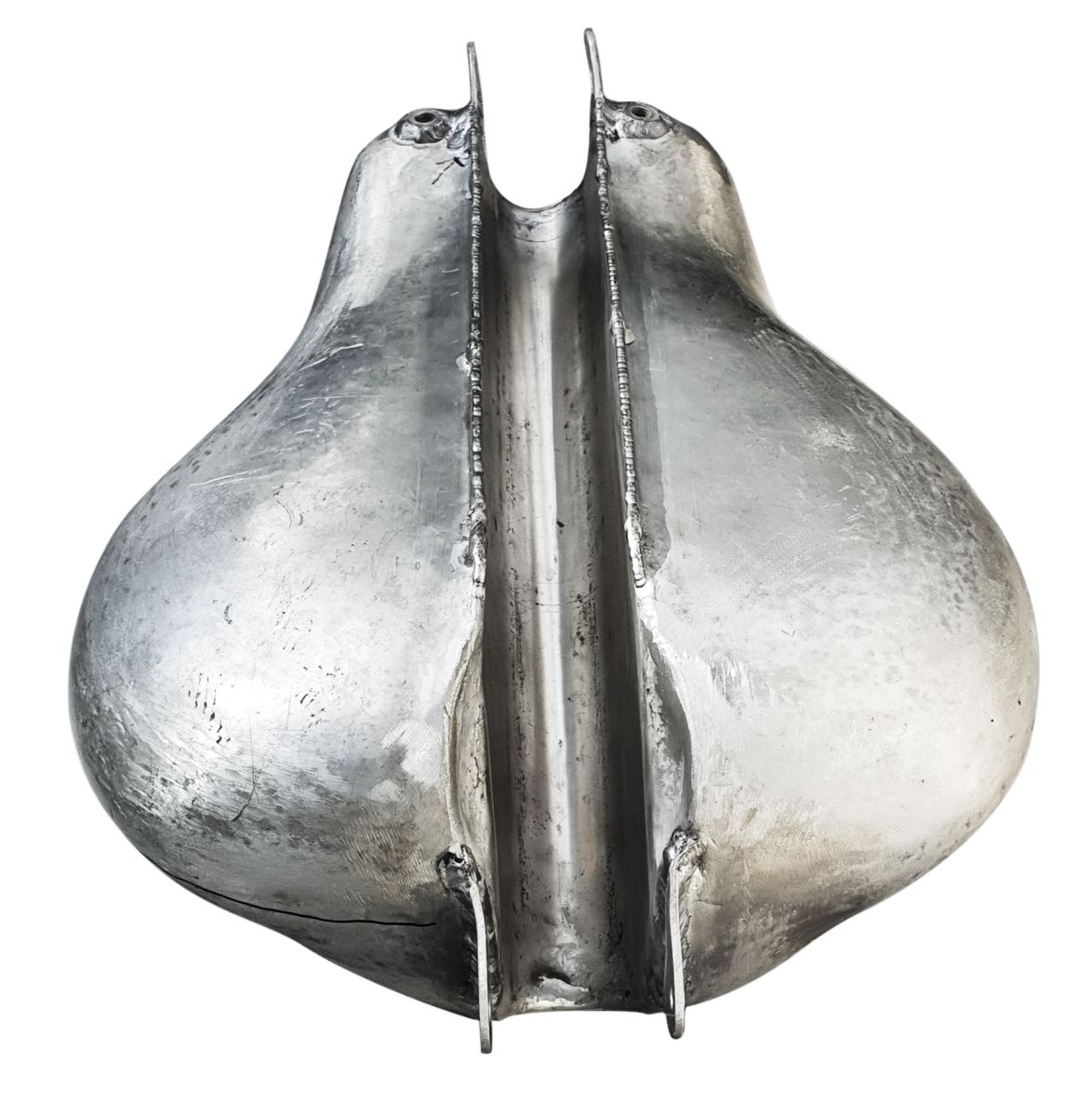
Primo’s life story
Based on this information, and as an owner of a Disco Volante 175 CSS (see OBA #89), I felt that I needed to purchase a copy of the book. Titled ‘Primo Felotti - A Life of Racing - Memories of a Lattoniere’, it was released in 2018 when Primo was the tender age of 94.
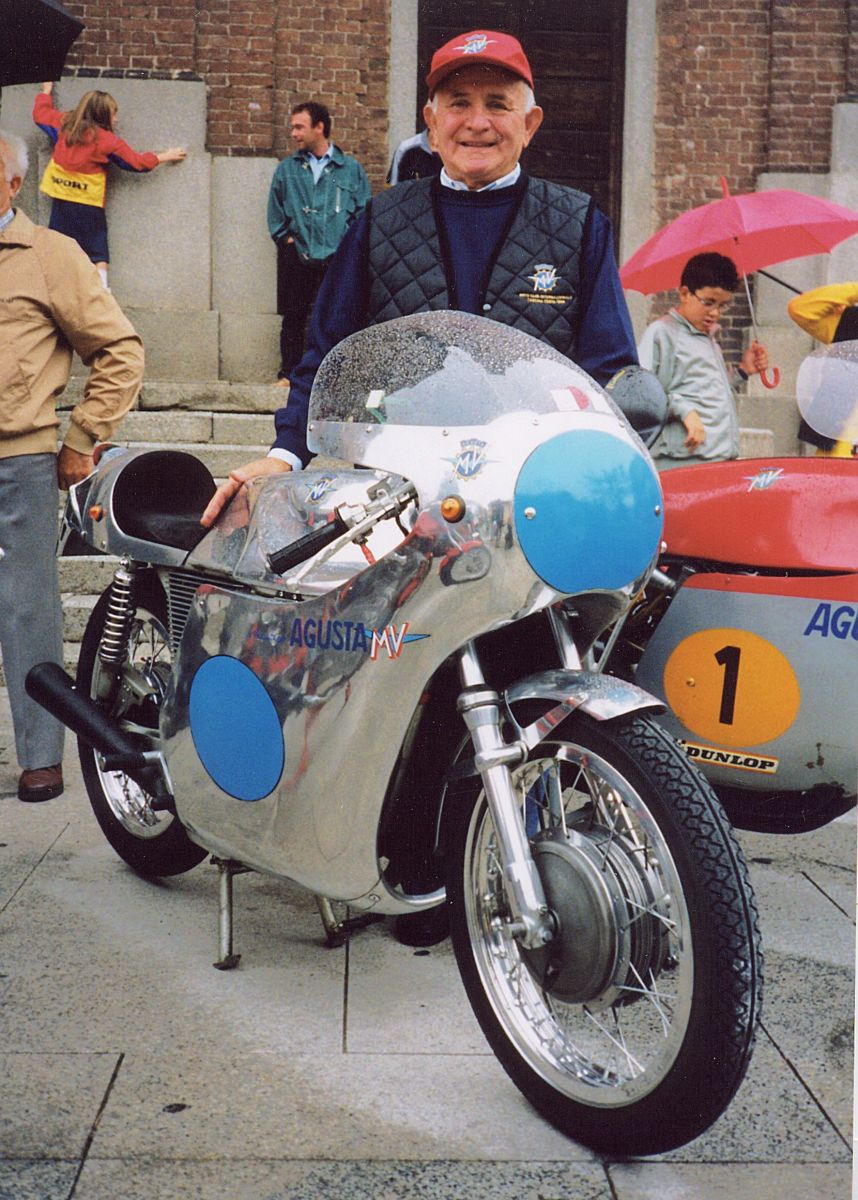 Primo on his 95th birthday
Primo on his 95th birthday
Lattoniere translates to ‘tinsmith’ which is hardly apt because this skill which transforms flat sheets of metal into works of art requires patience and supreme hand/eye co-ordination. ‘Sheet metal artist’ is a bit wordy so I guess we’ll just have to live with ‘tinsmith’.
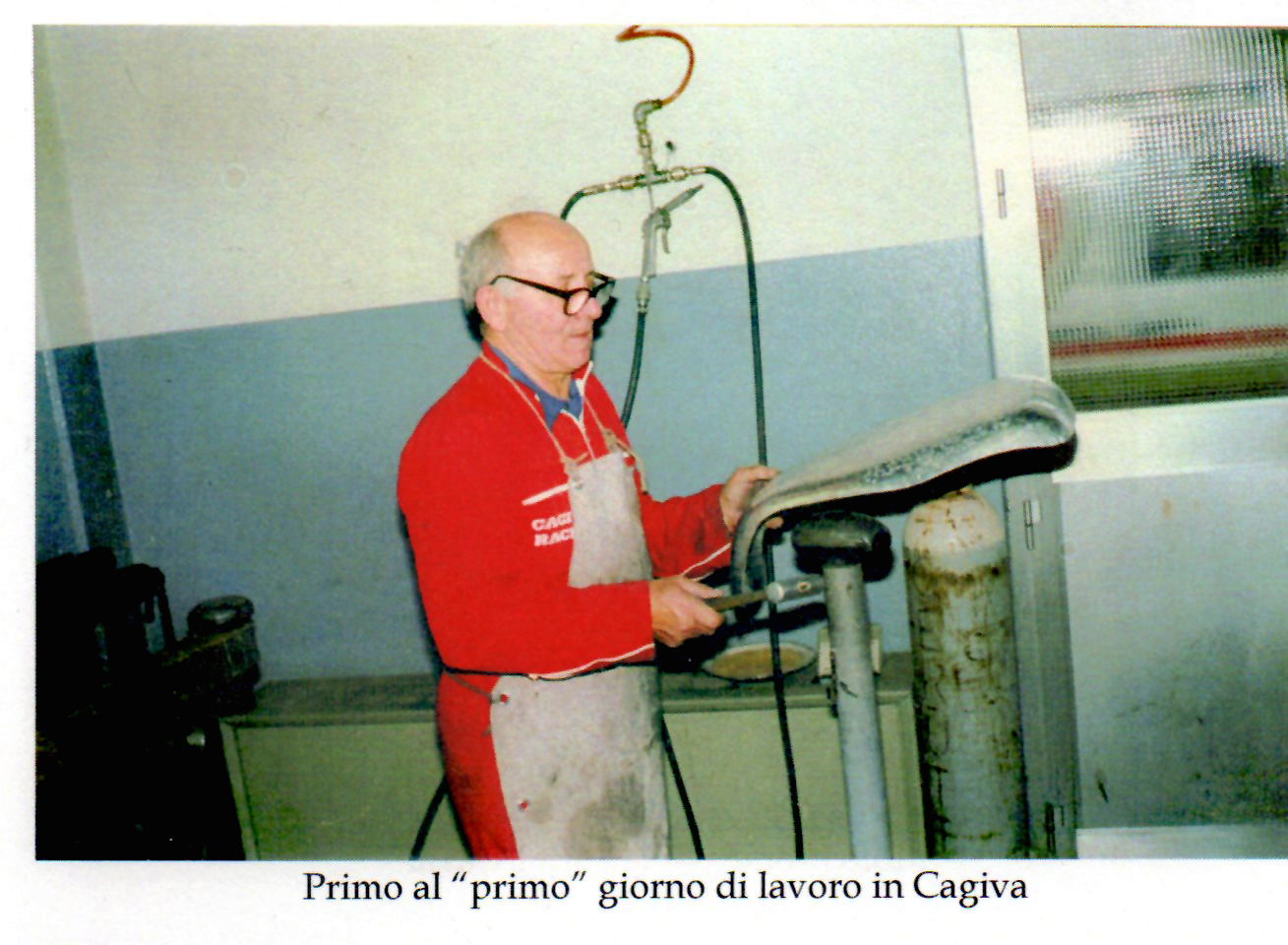 Primo working at Cagiva
Primo working at Cagiva
These guys are unsung heroes of automotive art. If you were to read about early MV Agusta motorcycles, acknowledgement would include the Agusta family, Magni, Remor (the engineers), the racers like Ago, Mike Hailwood, and John Surtees, the design houses like Giugiaro but not of the guys who profiled the beautiful fairings, tanks and panels. Primo was one of these little referenced guys. The only drawback for me is that the book is only available in Italian and so began a painstaking scan and translation of the 171 page paperback. Sadly, reference to the Disco tank didn’t make it into print but what motorcycle information he did include was such an exciting and emotional journey that l felt it necessary to share.
Childhood to apprentice
Primo Felotti was born to a large family of sharecropping farmers in 1924. His birthplace was Telgate, near Bergamo in the North of Italy. In 1930 the family moved to work for the Caproni family estates where life was a little better but they still didn’t even earn enough to feed themselves properly. This area of Varese was near a large moor that became an airstrip, which is now Malpensa Airport and was also close by to the birthplace of the Agusta brand. There was no future for the then seven (later eight) children in the Felotti family to all remain farmers. Primo was an exemplary altar boy for the local priest who happened to be teaching Latin to Mr Corrado Agusta. Primo asked his mother to approached the priest to see if he could ask the Agusta family for a job in their factory. So, just before turning fourteen he started an apprenticeship in the Lattoniere (tinsmith) department where two hundred workers formed panels for Agusta aircraft. Primo describes the noise as deafening, and it took a month of constant headaches before he could get to sleep at night. He was mentored by Mr Luigi Chinello a superb craftsman who saw Primo’s potential, took him under his wing and taught him all the tricks of the trade. Primo says the most important skill he learnt from Luigi was to work with ‘the head’.
Soldier V1
In June 1940 Italy entered the war. Primo continued with Agusta until the nation called all born in 1924 and 1925 to take up arms. This became a terrible part of Primo’s life under German occupation and at one point he was sentenced to execution for desertion. He was lucky to talk his way out of the situation and stayed safe until the war ended.
Pyrotechnics and Soldier V2
Post-war, there was little work available. Primo found dumped TNT in the local water course and used it to make money blowing out tree stumps for land reclamation. His brother was then called up for National Service but he had a steady job at the Caproni factory so Primo’s mother asked Primo if he would go in his place. He did and by the time he was discharged on the 6th May 1947 he had reached the rank of Corporal Major.
MV Agusta
Later in 1947 Primo found work forming panels for Caproni buses, then for truck rebuilds at subsidiary of Isotta Fraschini. He married his childhood sweetheart Margherita (Rita) in 1949. When Rita was expecting their first child Primo, tried to get work closer to home. He managed to get a job back at Agusta (which was now MV Agusta) making motorcycles as aircraft manufacture was forbidden for a few years post-war. He began making panels for the GLS 51 and CGT 51 scooters and his exceptional skill had him promoted as well as becoming the head lattoniere to the race department for the 1952 Italian and World Championships. His responsibilities included all the panels, tanks and fairings for the 125, 150, 175, 350 and 500cc race machines. To prepare all the race bikes for the season he said he was on the tools for 10 hours per day.
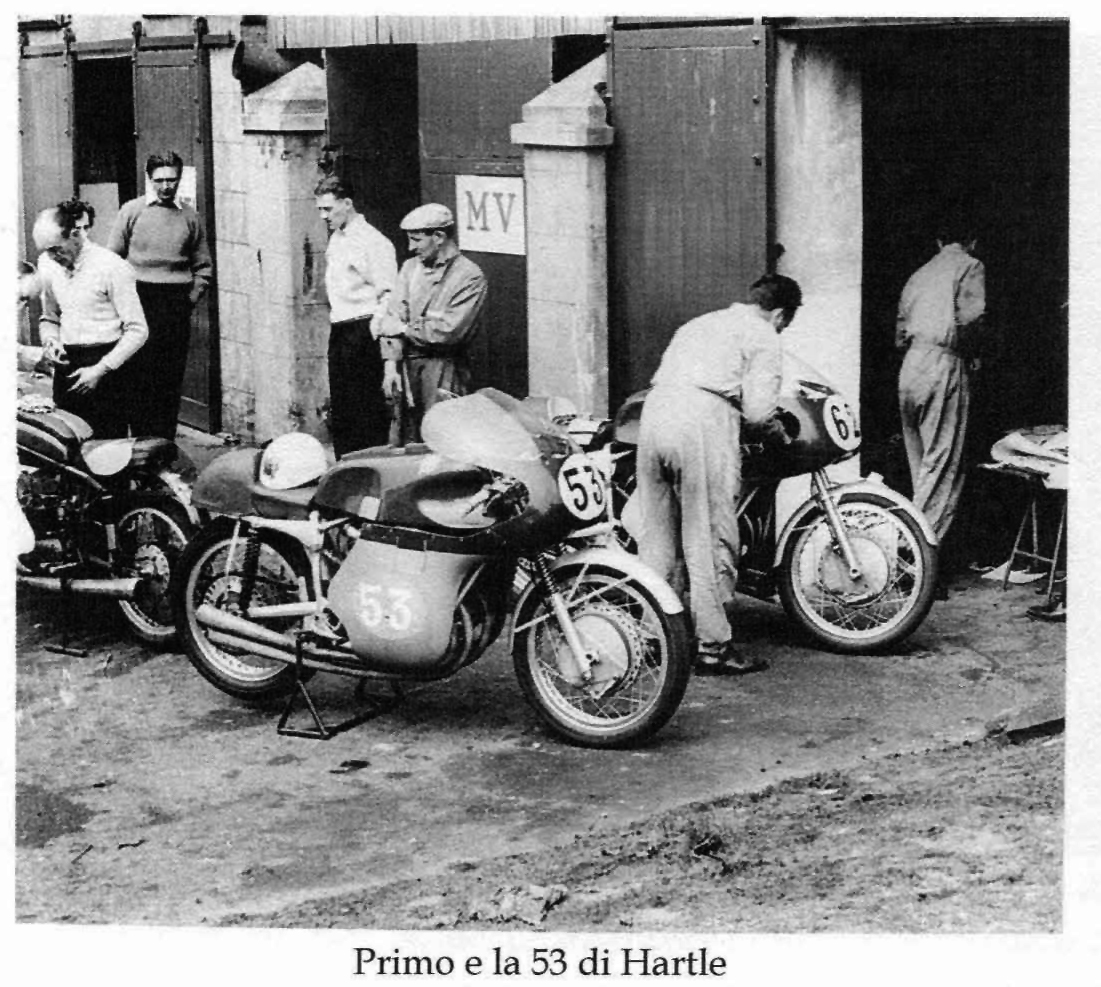 Primo behind Hartle's race bike
Primo behind Hartle's race bike
Count Domenico’s lucky charm
Primo cites the day his life changed in 1953 at the Italian Championship race in Faenza. Scrutineers disqualified Ubbiali’s 125 for a tail piece that they said was two centimetres too high. Count Domenico Agusta was not impressed and he summoned Primo to fix it quick. Primo marked a position and had a team member hacksaw the tail while he got the welding gear. He completed the change with 20 seconds to spare and Ubbiali went on to win. Meanwhile it began raining before the 500cc race. There was little hope for Masetti (on the MV) against Liberati (on the Gilera) who had never been beaten. Count Domenico asked Primo to sit with him to watch the race. Liberati easily took the lead as expected and was 25 seconds ahead of Masetti with ten laps to go when the Gilera began to misfire. Primo noted that the vent in the Gilera fairing was directing the rain onto the magneto, whereas his fairing vent was higher and had no such issue. On the last lap Masetti reached Liberati and overtook him for a sweet victory. The elated Count then turned to Primo and asked his name. He then christened Primo his ‘lucky charm’ and told him to arrange a passport pronto as he was to accompany the race team on the World Championship circuit.
%20with%20Provini%20visually%20satisfed%20after%20the%20race.jpg) Primo (with cap) with Provini visually satisfied after the race
Primo (with cap) with Provini visually satisfied after the race
World Championship Circuit
Primo’s relationship with Count Domenico was now cast in stone. During Primo’s long career with the race team he also got to know many MV racers. While there was the excitement of many wins there was also a terrible sadness for the many that passed away in his presence. Primo gives a short summary of many of these racers from his perspective. These riders include, Les Graham, Carlo Bandiola, Angelo Copeta, Nello Pagani, Ray Amm, Fortunato Libanari, Luigi Taverni, Umberto Masetti, Remo Venturi, Jon Surtees, Carlo Ubbiali, Roberto Colombo, John Hartle, Mike Hailwood and Bill Webster. Primo includes many stories about his special race experiences.
1 Second a Lap Fairing
One story I enjoyed was from 1958 at the Monza round. During practice, Primo was finishing a new more streamline fairing design in the truck. Degner on an MZ was consistently 1 second a lap quicker in both the 125 and 250 class which didn’t sit well with Count Domenico. Primo volunteered that there was just enough time to fit his new fairing to see if it would make a difference. The Count ordered it mounted immediately. By the second lap, Degner’s time was matched so the Count then summoned Primo to get in his Cadillac and they hurried back to the factory so Primo could build another for the 250. Primo thought this was a good time to ask for a pay rise, but on the journey, they got cut off by a Fiat 500 so he decided to keep quiet as the Count became furious. The factory was empty so Primo worked all night alone to have the fairing ready by 8:00am to catch a truck to Monza. The 250 was also a revelation and Ubbiali went on to beat Degner on the last lap in both the 125 and 250 races.
Isle of Man
Another account was on the lead-up to the 1959 Grand Prix of England at the Isle of Man. Primo was at home rushing to make two new fairings for the 125’s. He worked a day and a half without sleep to have them completed, painted, fitted to the bikes and loaded on a plane on Saturday morning. Primo had a couple of hours before his flight so went to get a much-needed haircut. He hadn’t returned and the departure time was approaching, so Rita went looking and found him asleep in the waiting area at the hairdresser. Still with no haircut, he only had time for a shower but got to the track to see Surtees take the 500cc event and Provini take his new fairing through to victory in the 125’s.
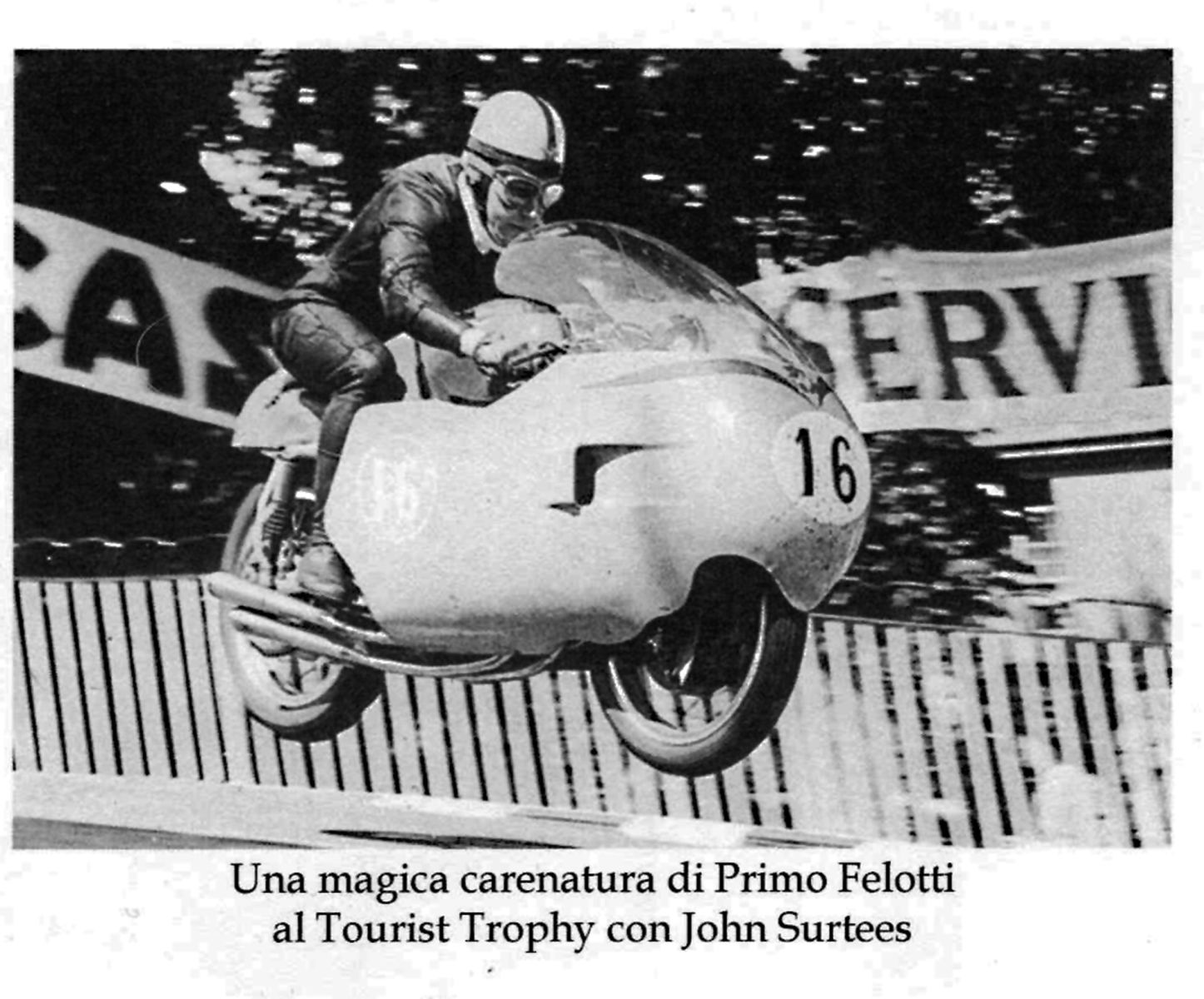 John Surtees at the Isle of Man with one of Primo's magical fairings
John Surtees at the Isle of Man with one of Primo's magical fairings
Agusta-Bell
A few years after the war, aircraft manufacturing was resumed in Italy. The origin of Agusta was aircraft and it again became the dominant part of the business as they invested heavily into helicopters. In 1961 the MV race team was trimmed back and they only competed in the 500 class. Primo’s dominant job role became helicopters also. In 1966 he was responsible for the panels, jigs and manufacturing training for building the Agusta-Bell 206. Subsequently, he did the same for other helicopter models and a significant portion of the book covers this part of his working life.
Countdown
Count Domenico passed away in 1971 and it is well documented that he was the main reason that the motorcycle side was supported at Agusta. The race department continued in a less urgent way after his passing. In 1973 Primo crashed his motorcycle on the way to work, resulting in a significant time in hospital to recover. Still frail, he returned to work only to be urgently summoned to Franochamps for the closely contested finale to the World 500cc Championship. Mr Corrado Agusta was a little superstitious and aware that his late brother Domenico considered Primo as the ‘lucky charm’. Success at Franochamps brought the decider to the final round in Finland again with Primo present. Bonera and Read on MV’s were up against Agostini who had moved to Yamaha. The race plan was for Bonera to hold back Ago and let Read get a lead. When the lead was healthy, Bonera was given a signal that he was free to race. He was very fast and quickly caught and passed Read with ease, but this was mainly to prove a point. Bonera was also under instruction to let Read win which he unceremoniously did on the last lap with twenty metres to go when he raised his hands in the air and slowed up dramatically. Read and MV were the World Champions. Primo said that Bonera was a very good racer and deserved to be World Champion. He still joking greets Bonera calling him a ‘donkey’ for letting Read win, but Bonera just laughs it off. 1973 was Primo’s last time with the racing department of MV Agusta.
MV’s Finale
1973 also saw Agusta join the EFIM group. Strikes were very frequent and to sabotage production the unions did an hour of alternating strikes which cut productivity and stressed Primo so much that (he believes) it led to a stomach ulcer. Although full-time with helicopters, he was asked to hand-make the tanks and panels for three new MV Agusta models. They were the 750 America, the 350 Ipotesi (designed by Giugiaro), and the 125 Sport.
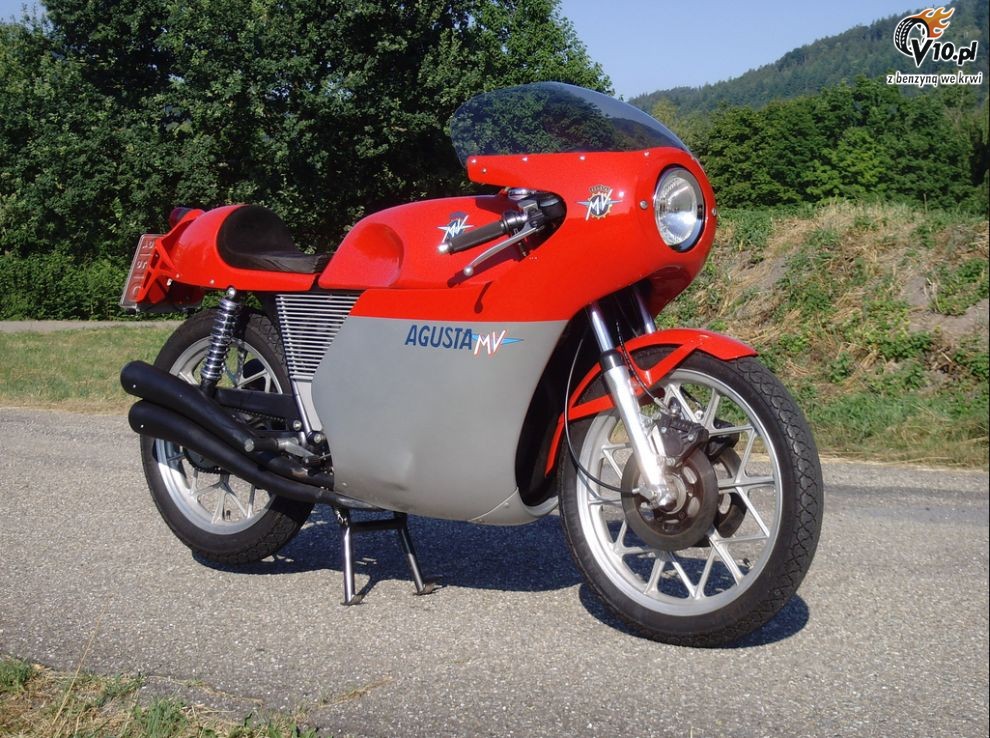
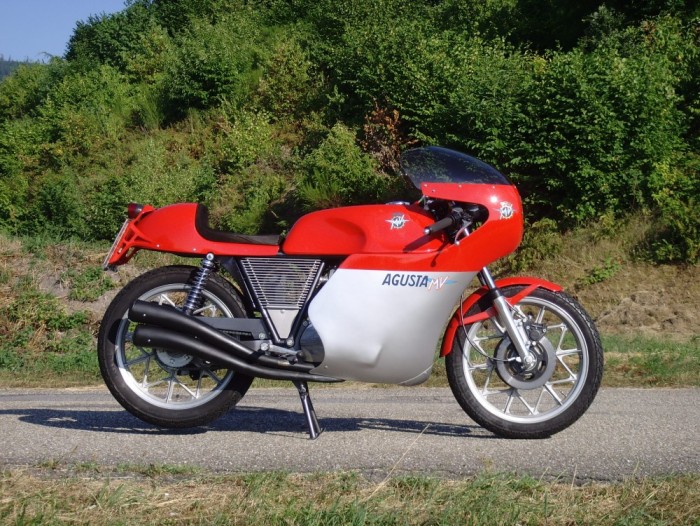
Primo Felotti restored 350 Ipotesi
Primo did most of the work at home and overnight. It was meticulous work but he loved the challenge. For this work he was offered 700,000 Lire but he only accepted 400,000. He recounted this story to Cagiva engineer, Azzalin, who told him he was mad for accepting such a meagre sum. Primo replied that this was true but that he loved this type of work so much that the satisfaction of seeing the birth of an MV bike, built entirely with his hands, was to him, the most precious compensation. Production of motorcycles at MV ended with these models in 1977, the last stock being sold in 1980.
Cagiva
In 1981, Primo was invited by ex-MV racer Gilberto Milani to meet with the Castiglioni brothers. They owned Cagiva and were racing in the 250 class at the time. They had a 500cc racer reaching completion but needed fairings and bodywork. Gilberto knew Primo’s work and wanted him to join them. Primo said that he still wanted to end his time at Agusta. Mascheroni, an engineer, present at the time suggested that Primo was just hanging around to get a gold watch and with that, Claudio Castligioni removed his gold Rolex and handed it to him. Primo declined but pledged that he would start with Cagiva the day after he left Agusta. He continued, offering that, as he didn’t work for Agusta on Saturdays he would build their fairing then. He continued working for Cagiva on Saturdays for three years also making bodywork for their successful Motorcross racers.
One Door Closes...Another Opens
On Primo’s last day at Agusta in 1983 his co-workers surprised him by presenting him with a ‘Parchment of Commendation’ and an aluminium plaque complete with an attached hammer and all their signatures. They carried him on their shoulders out to the front gate singing the words that they “were carrying out the finest leader of the Lattoniere, who always helped workers in distress”. Such a thing could only happen in Italy. Ten days later Primo entered the Cagiva Race Department at Shirianna and for four years faired four-cylinder race bikes for the likes of Virginnio Ferrari and Marco Luccinelli.
The ‘Elefant’ in the Room
After the races in September 1988 Primo returned to his workshop (where he worked alone) to see a stripped down Ducati 1000 surrounded by a Cagiva modeller and two engineers. Primo watched as a couple of weeks went by without much progress. Primo was in affect just a consultant to Cagiva so they didn’t ask for any input even though they knew his abilities. The modeller and Director of Works, Azzalin, finally approached Primo and asked if he would be interested in making a tank for the bike to compete in the Paris-Dakar Rally. He said yes and asked how many litres did it need to hold. The more the better but 50 litres would be sufficient. They presented him with their timber mould but he said he didn’t need it which he suggests may have offended them. One week later it was done. They looked it over and then filled it to check the capacity. Exactly 50 litres and they were also impressed that he was clever enough to keep the centre of gravity low. Azzalin took Primo’s wallet and filled it with 500,000 Lire as reward then asked if he could make a small 20 litre reserve tank. Next, they requested a sump guard and then the dual headlight front fairing and mudguards. Primo incorporated quick-release fixings, the fuel couplings from his racing experiences and added compartments for spare tubes, water, tyre levers etc. They couldn’t believe how he left room for the rider and fit everything so precisely without drawings or moulds. He then prepared three other bikes which were completed by the end of December. The Cagiva Elefant won many stages and gained the name the “Empress of Africa”.

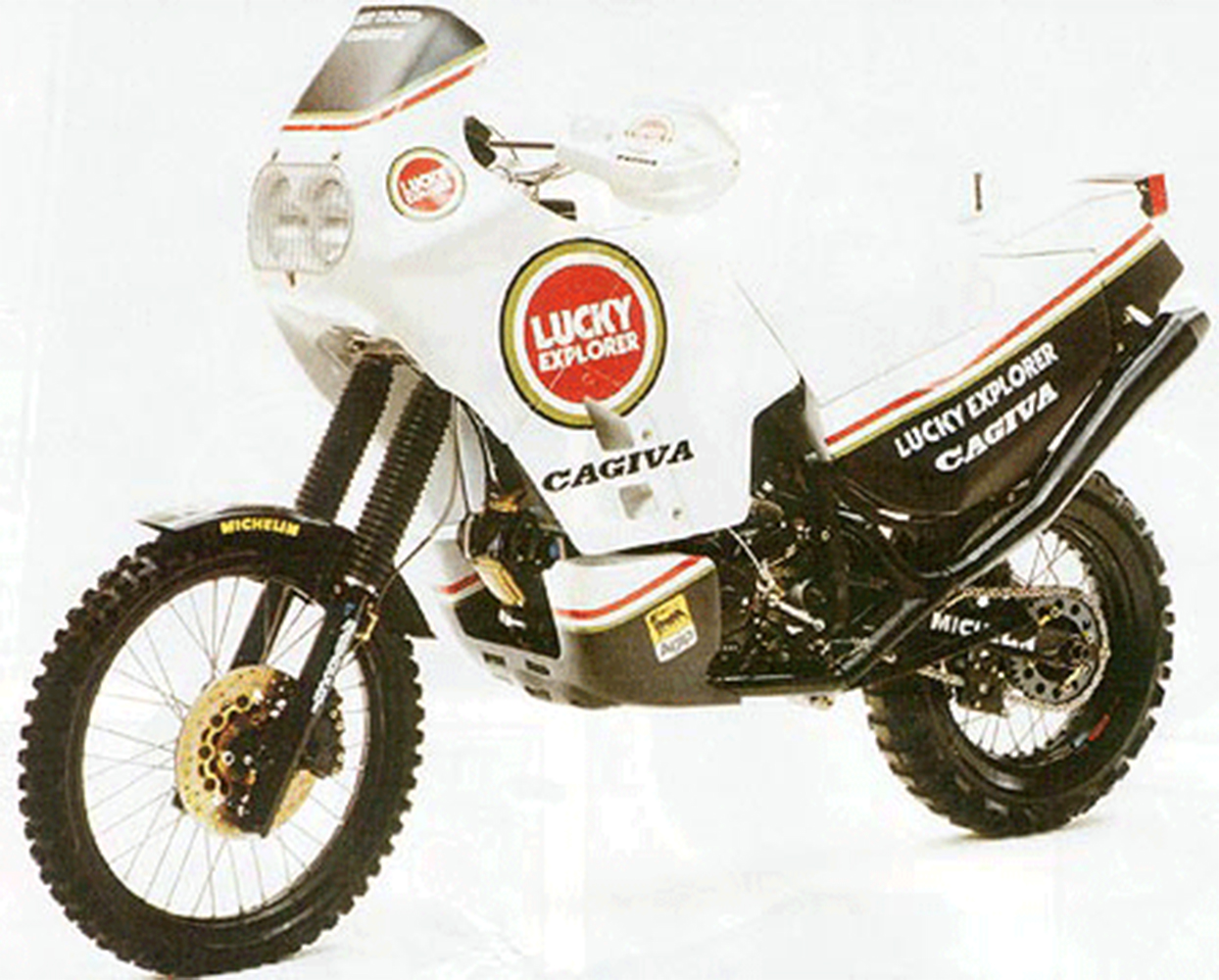
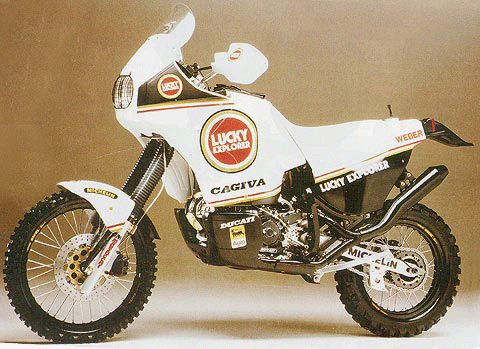
Cagiva Elefant at Paris Dakar Rally
Primo was even a vital part of the rally entourage. He writes about the good times and equally the sad, for example, the day he was left in custody of rider Marinoni’s personal effects. He crashed 15km from the finish but remounted against medical advice and which ultimately proved fatal. Primo’s work was included in subsequent Paris-Dakar Cagivas until the end of 1994 when he retired, by this time he was 70 years old after all.
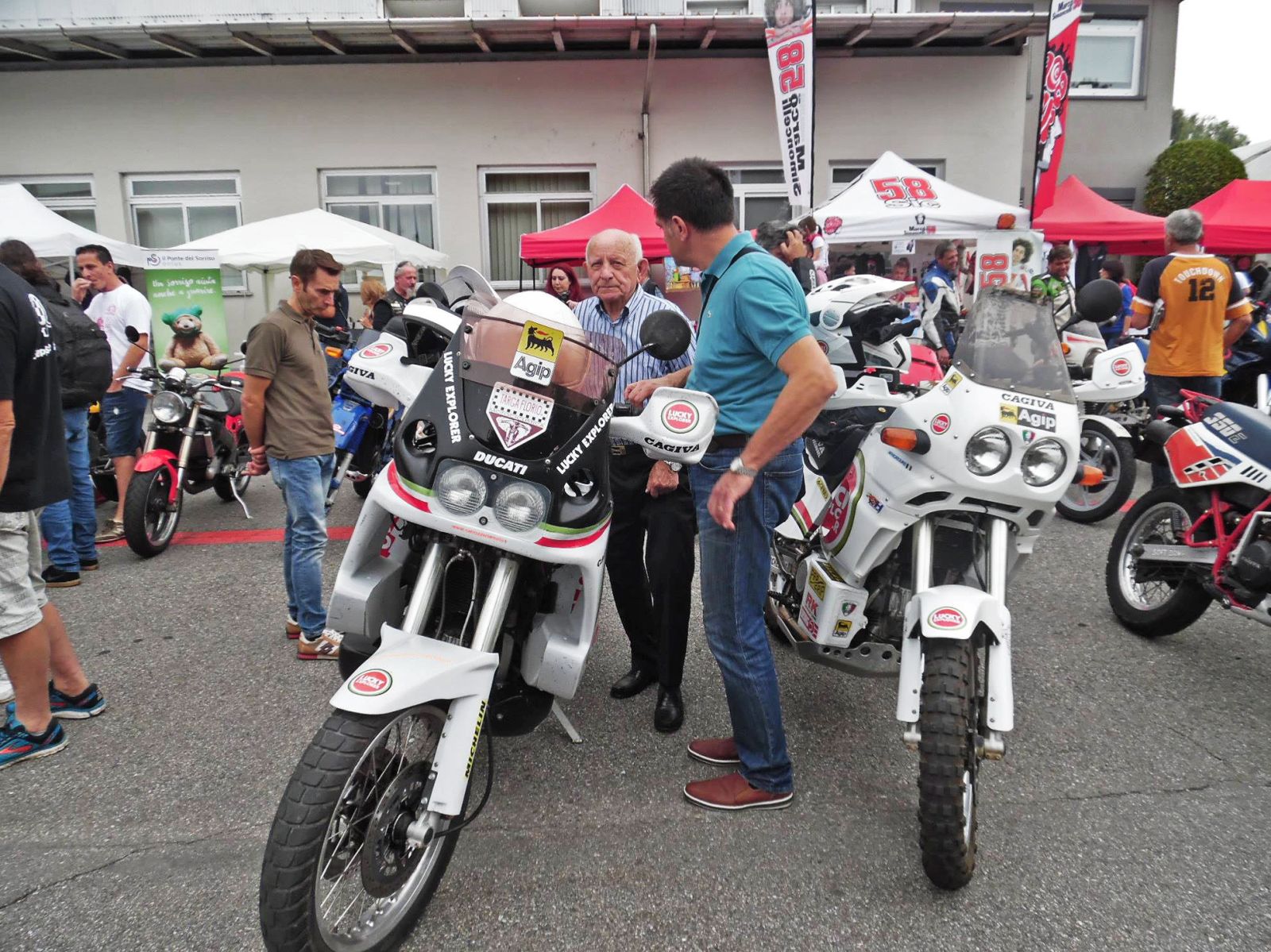
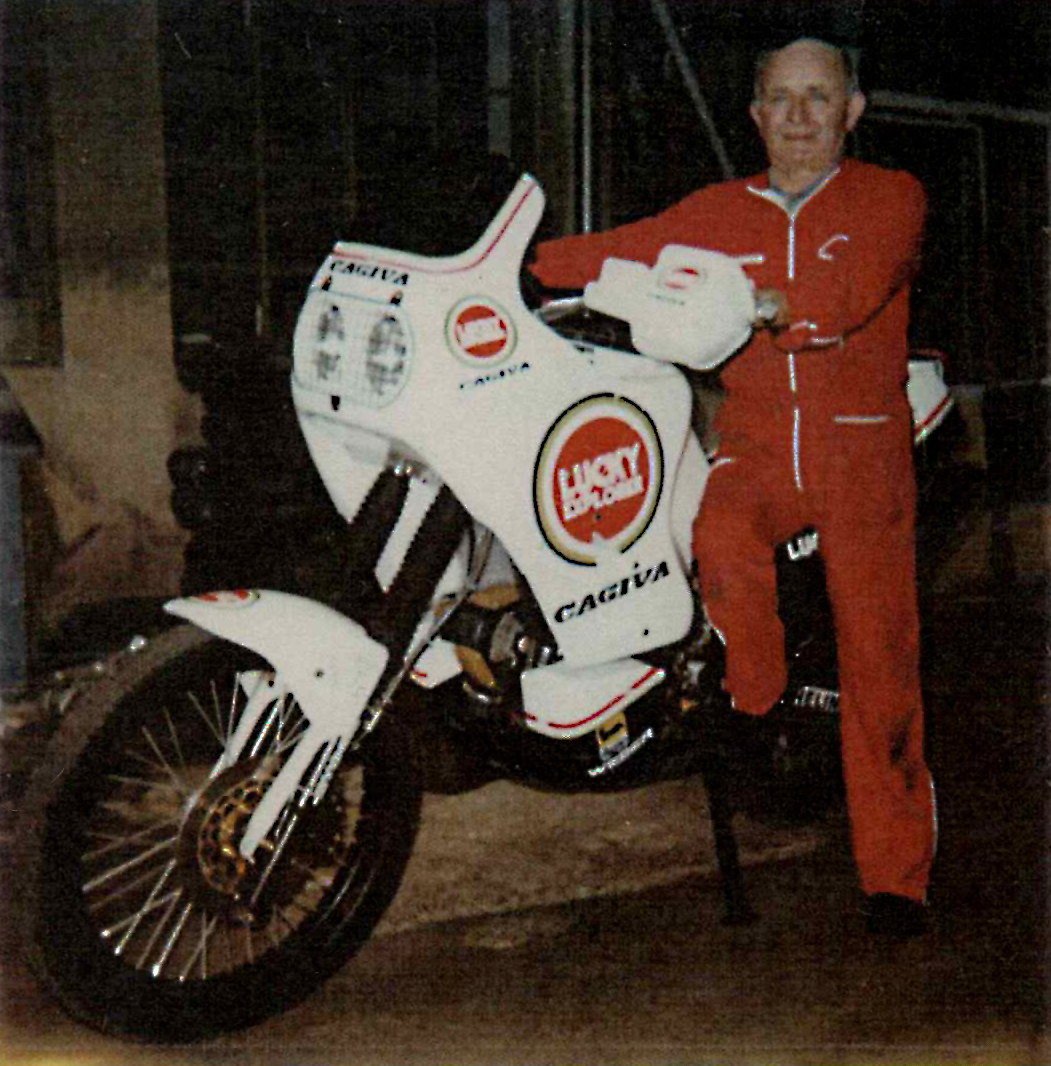 Primo with his Cagiva Elefant creations
Primo with his Cagiva Elefant creations
In the book Primo wrote these heart-felt words “With the Castiglioni brothers I spent beautiful years, almost like those passed with Mr Domenico and with the whole family Agusta. Those, in the racing world, were the most beautiful years of my life”.
%20with%20Edi%20Orioli%2C%20De%20Petri%20and%20brothers%20Castiglioni.jpg) Primo (behind right) with Edi Orioli, De Petri and brothers Castiglioni
Primo (behind right) with Edi Orioli, De Petri and brothers Castiglioni
Hammering On
Primo was never going to hang up his hammer, so he turned work into a hobby. He restored his old MV 125 and then gave it to Bonera (remember ‘the donkey’). He then found a neglected 350 in Turin which he restored and modified to resemble a race bike. He restored about fifteen machines and still retains around half of them. He has also built MV’s to order for enthusiasts. He wrote in his book that one of his creations went all the way to Australia. Photographs of this particular beauty can be seen on (world renown photographer) Phil Ansley’s website as well as a story in OBA Continental Classic magazine. The Castiglionis acquired the MV Agusta brand in 1992 and slowly but surely went about rebuilding the once famous brand. Primo was a special guest at the launch of the new F4 in 1998 and given the honour to remove the cover to show the world. In 2010 at the launch of the F3, Claudio was already ill but he greeted Primo with a huge hug and relocated him to his table during the ceremony. Claudio again insisted that Primo have the honour of removing the cover.
Primo was extremely saddened when Claudio passed away in 2011.
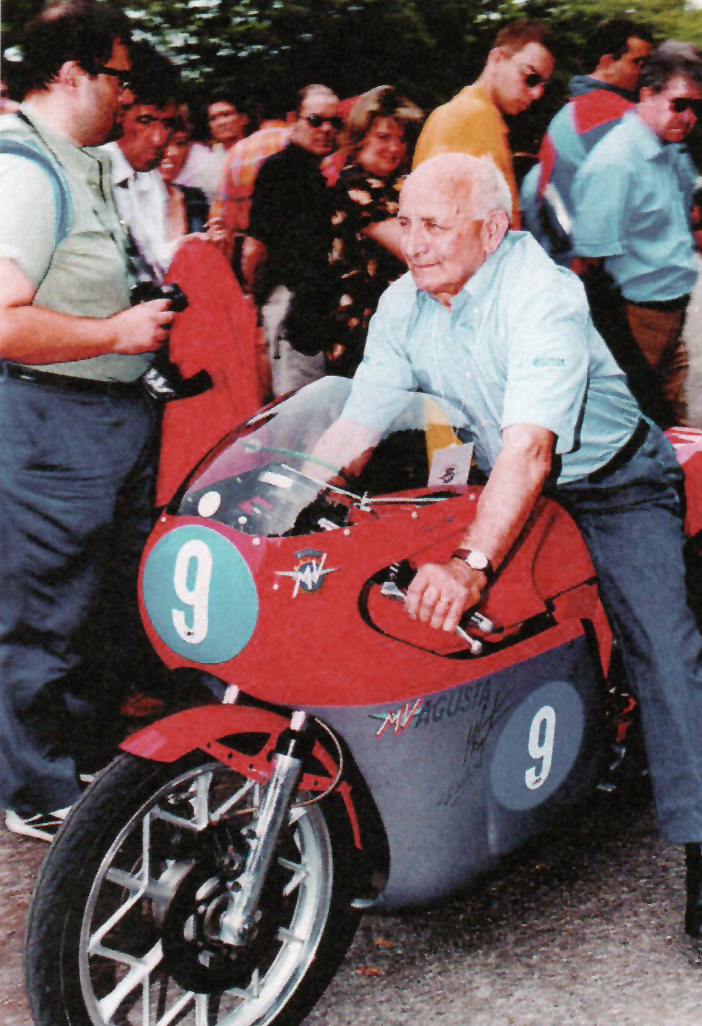
Pleasure and Pain
In September 2011, Primo was invited to perform the first lap at the “Revocation of the Gallarate Circuit” event. He prepared his most beautiful MV350 for this. Before the off, the announcer divulged that Primo was 87 years old, to the applause of the crowd. He was escorted both sides by urban policemen and after the first lap he signalled he wanted to keep going. The police were too slow for the racy 350 engine so he gave it a bit more throttle which sadly led to a fall. He felt no pain and wanted to get back to watch his nephew (Emanuele) do his laps. He was taken to hospital by ambulance where they found three broken ribs and a damaged knee which angered him as it ended his goal of riding until he was 90.
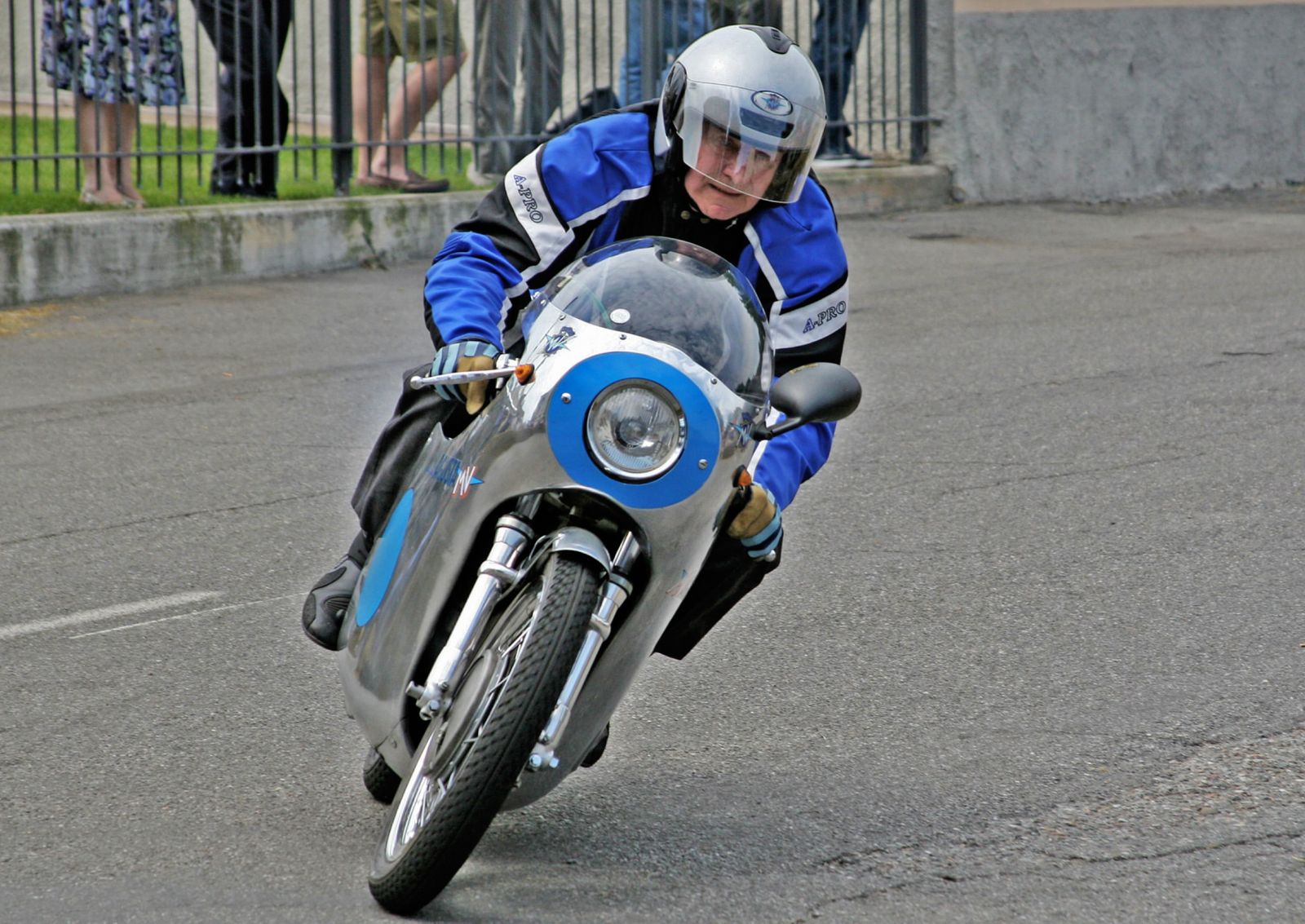 Primo on his MV 11th Sept 2019 MV revival
Primo on his MV 11th Sept 2019 MV revival
Next Chapter
Primo will be 100 years old in 2024. He has already left the motorcycling and helicopter community with a fantastic legacy. I wish him many heathy future years, and in that time, I wish he could fill the gaps left in his book. Specifically, his contribution to each of the road and race MV’s, Cagiva models and also the ‘reported’ contribution he made to Arturo Magni’s creations.
La Finale
Since I penned this story in 2021, Primo did make it to 100 years of age but in February of 2025 he passed away. Very sad, but every now and then I’ll pat the tank on my MV and say thank you Primo. RIP Primo Felotti. Thanks for the ride.
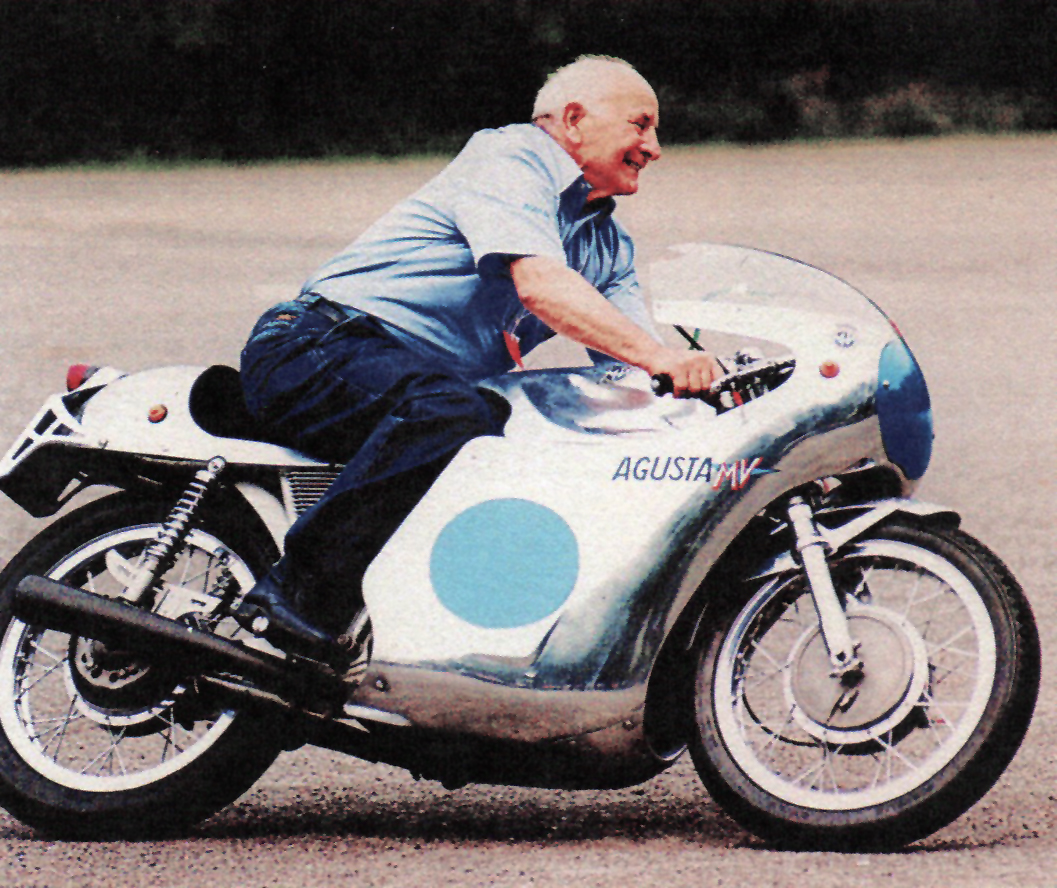 Primo on his MV 11th Sept 2019 MV revival2
Primo on his MV 11th Sept 2019 MV revival2





